#Lost City of Lyonesse
Explore tagged Tumblr posts
Text
Help Me Name My Next Book! Uncover the Secrets of the Lost Kingdom of Lyonesse! 🏰🗝️ Book Deals and Freebies Await! 🎉
Hello, my Freaky Darlings! Greetings from the somewhat less frigid arse-end of Africa. Well, we’ve managed to avoid any bizarre gas explosions this week—hooray for small victories! However, we can’t say the same for the protest actions sprouting up all over the place, with burning tires and emergency service providers playing hide-and-seek with danger. It’s like watching a real-life game of cat…

View On WordPress
#Author Updates#Book Sales#Book Title Quest#Dark Urban Fantasy#Exclusive Deals#Fiction Writing#Free Book Offers#Lost City of Lyonesse#Lost Kingdom of Lyonesse#Lyonesse Legends#Thriller Fiction
0 notes
Text
A letter to Lyonesse
'' Dearest Kings of Lyonesse, The Lycans from the north have invaded our city and have taken the castle. We lost all contact from our Princess, rumor has it that Ulfur, son of their Warchief, has taken her hostage. As one of her Majesty's generals and cousin, I'm afraid his true intentions go beyond conquering Antireach. He might set foot on your doorstep next. I call out to you for aid, praying this letter may reach you in time. The wolfs have completely taken over our city, myself and our men are considered outlaws and are either captured or into hiding within the lower parts of the city. Follow the Ravens. Sincerely, Prince Cailean Lasair Ash of Antireach -------------------------------------------------------------------------- Original Story - Rise from the Ashes Written by me and Goddessart10 Please don't copy or use this writing as your own, Thankyou.
#Rise from the Ashes#Goddessart10#graywitcharania#A letter to Lyonesse#writing#fantasy writing#creative writing#writers of tumblr
2 notes
·
View notes
Photo
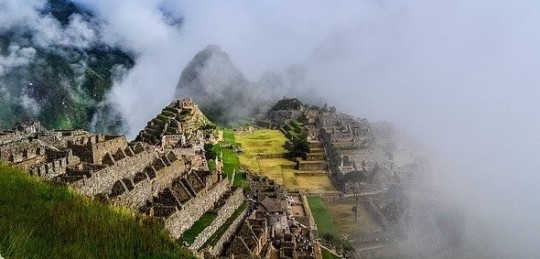
The lost city of Atlantis has never been found. El Dorado, the legendary city of gold, has also never been found. Lyonesse is the home country of Tristan, in Arthurian legend. Supposedly it's at the bottom of the sea. Some lost cities have actually been found. But they weren't really lost. It's just that they were forgotten. Learn more: cmoneyspinner1tf.substack.com/p/sharing-my-fascination-with-lost-20-02-03 #History
0 notes
Text
Lyonesse

A place of legend, home of a love story for the ages
Now named a "Lost Land", swept away by rising tides and many moons
Where does the legend end and the truth begin on such a place thought very much to be veiled in truth
Quite a large place, keeper of many village's
Suddenly as like that of pom pae, it was simply swallowed by the waves
The entire are lost, animals and people drowned
Once taken, the sea never gave anything of it back to future man
Once thought to be a lost isle if Scily, what's was lost will never be found
Such a fate invoke a variety thoughts and emotional reverence
A lost city based very much in truth, truth based very much in ancient past
Image: ancient city lost to the sea pics
Let me know what you think and pass the thought along.
#M'Leigh#MLeighQS#mlp#lyonesse#lost city#poem#poems#poetry#poetic#questions#thoughts#conversations#interworld#muchlove#Patreon#Instagram#Twitter#Facebook#random poem#random piece#random post#random thought
15 notes
·
View notes
Text
A Concept:
So there's all these myths and legends about different lost cities right? The most commonly known like El Dorado (Lost City of Gold) and Atlantis. But then there's ones like the Lost City of Z (zed), the Lost City of Aztlan, the Lost Land of Lyonesse, and the Lost Desert Cities of Dubai, (maybe there's others)...
So what if these, all of these, are really one ancient city, that no one has ever found. Guys storytelling used to be really different. Before things started getting written down it was all oral, and when a story is told over and over it tends to get embellished.
So what if there were groups of people that migrated away from this city or knew of it, and when they went back to their lands/homes told stories about it. And that's how there came to be these myths/legends about different lost cities but it's really just one city...
#myth#legend#lost city of z#lost city of atlantis#lost city of aztlan#lost land of lyonesse#el dorado#lost city of gold#lost desert cities of dubai#storytelling#a concept#lost city#story idea?#writing prompt
17 notes
·
View notes
Photo


A couple of maps, where I live in perpetual salt because there’s PROBABLY a much more reasonable way to do this but I just did them by hand because I’m a masochist or something (while still trying to match the style of wonderdraft maps). The cities of Lyonesse and Ys, enduring even in Old World mythology as fabled ‘lost lands’, live on within Genesis as thriving mage cities. They���re well-known as centers of light and learning, and would-be apprentices travel here from the length and breadth of the hidden world in hopes of showing enough magical aptitude to be taken in by a mage circle.
#fantasy cartography#mapmaking#lyonesse#ys#lost land#genesis#worldbuilding#worldanvil#bloodlines#maps
32 notes
·
View notes
Text
Tales of Aeora 1.6
🔷 Link
"An Analysis of Medeva’s poem, ‘Phrixus and Helle,’ in Relation to the Formation, and Orbit, of the Early Moons of Aeora”
By Thomas Apollinus, a member of the Society of Alchemists
Published in 622 A.D.
Summary
"The following article attempts to reconcile the debate over whether or not Medeva had access to information regarding the formation, and evolution, of the early moons of Aeora (Phrixus and Helle). There is a modern-day belief that Medeva had access to secret knowledge through her mother, Luna, and the other gods. We argue, however, that Medeva had access to exclusive records on time-reckoning, through the Society of Alchemists, and that she used complex metaphors to describe relationships that she perceived in the natural world. Unfortunately, Medeva’s advanced metaphors (and perception of the world) led many to believe that she was not entirely mortal."
Article
Contemporary scholars wonder to what extent the ancients knew about the rotation, and formation, of the moons and planets in our solar system. When “Phrixus and Helle” was written by Medeva, sometime Before the Destruction (BD), ancient astronomers relied on three methods of calculating a year – one lunar, one solar, or a hybrid depending on the civilization. The country in which Medeva lived is unknown, but historical evidence indicates that it rested somewhere between the ancient empires of Kemet and Valentia (1). The system of time reckoning for both of these civilizations is beyond the scope of this essay, but it should suffice to say that Kemet relied (primarily) on a lunar calendar while Valentia dated their months according to the sun (2). Claims by Medeva, and her supporters, that the poem was presented to her by the spirits of the two moons – Phrixus and Helle – has prevailed into modern theological discourse. However, it seems far more likely that the poem was written using the knowledge of time calculations of the Kemetian and Valentian empires, as well as Medeva’s own knowledge concerning the formation of the moons based on her study of her former husband’s research.
The structure of the poem indicates that Medeva had some knowledge about the orbit of the moons, but to what extent is still debated. For example, each stanza is introduced by the name of a season associated with the solar year. Scansion of the poem’s form and meter, however, indicates that each stanza is made up of thirty feet of either iambs or trochees (depending on the season) plus a triplet of twenty feet at the end, or 140 feet in the entire poem, which suggests that Medeva refers to a lunar year in her work (which is comprised of 140 months and begins with the total eclipse known, to the ancients, as the Morte Kalendis — described in line 24). Her follower’s assertions that the poem was a revelation sent by Phrixus and Helle are completely unfounded; still, there is clear indication that Medeva was aware of the months in a lunar year and that they were somehow related to the seasons.
During Medeva’s lifetime, there were several groups who devised calendars based on the phases of the sun and the three moons. Many of the early calendars, specifically those in Kemet and Valentia, influenced our own modern systems of time reckoning. In the temples of the Khonsu, in Karnak (where Medeva is rumored to have visited), ancient astronomers began their lunar year at the day of total eclipse (2). Furthermore, the Society of Alchemists started to observe the orbit of the moons and developed our modern system of date-keeping. Jason would have been aware of these developments and might have shared them with his wife, or Medeva might have stolen the information from her husband’s library when she fled the country. The poem could have been written sometime after her flight since the final couplet references a “paper boat” (lines 27-28). Due to the discoveries of her husband, and the Khonsu, Medeva could have been aware of the number of times Luna orbited the earth in one rotation of Phrixus (being 140 or the number of months in a lunar year). Rather than a vision transmitted by the gods, it seems more likely that Medeva wrote poetry inspired by the early scientific discoveries of astronomers such as her husband.
The records Jason kept, translated for generations by the Society of Alchemists, describe Medeva as a sorceress who didn’t reveal her true identity until years into their marriage. On the night that she was sentenced to prison, she fled her country on a boat across the Seventh Sea – stealing several rare and valuable documents from the organization archives before she left (4). Although Jason never wrote about the conclusion with his ex-wife, historical records (see the letters of various pirates off the coast of Elithrea) suggest that she traveled toward the coast of Kemet where she settled with the Khonsu. Scientists speculate that Medeva brought the records of Jason the Astronomer with her, transplanting them on the eastern continent and in the hands of Khonsu priests and priestess (thus adding to their own research concerning the movement of the moons).
There are some documents that make it appear as if Medeva had access to information about how the solar system was formed, however this has been pure speculation. Her assertion that Phrixus “burned as punishment, thick band of ash and sulfur tore apart the sky” (lines 11-12) and that before this a “grey light, reflected, showed” (lines 1-3) demonstrates that Medeva believed that the moon, Phrixus, was not always the swirling red and black that we see today. Modern science has revealed that, before a stellar collision in our moon’s past, Phrixus would have looked like a small Luna or (more likely) a large Helle. It is likely that several large impacts from a period of heavy bombardment pummeled the moon, causing its surface to rupture and spew magma, as well as form lengthy volcano ranges – leaving behind the burning, smoky atmosphere that we witness today (3). However, the Society of Alchemists weren’t even aware of this fact during Jason’s lifetime, and it is not clear how Medeva knew as much as she did about Phrixus’ ancient past. Scientists hypothesize that the asteroids and meteors that caused Phrixus’ crust to shatter occurred before the evolution of life, and is therefore put forward by zealots as evidence that Medeva was in communication with the gods. Such assertions give too much credit to Medeva’s artistic comparison between Phrixus and the moon, Luna. It would not have been a stretch for her to imagine Phrixus, especially if he were as personable as she suggests, having once looked like one of the other moons.
Another problematic piece of evidence — Medeva claims, at first glance in accordance with modern scientific discourse, that after he burned Phrixus “called his twin flame,” Helle (line 13). It is known that Helle and Phrixus were formed together during a probable collision between Aeora and a large stellar body billions of years ago, making them “twins” in a sense. It is likely, however, that Helle received a large portion of ice from Phrixus during the most recent period of heavy bombardment – causing its current, oceanic appearance. Once again, modern philosophers are baffled by how Medeva could have known these facts but the answer is simple: she didn’t know them. The description of Helle being summoned by Phrixus is a reference to their (obviously) dependent relationship in space. If zealots would peer more closely into Medeva’s work, they would note that her poetics are not a revelation but a metaphorical analysis of what she perceived in the night sky coupled with the knowledge she stole from early astronomers. The “mysterious” methods by which she obtained this knowledge was not divine or visionary, but a byproduct of human reflection on the natural world.
The author hopes that this article will dispel the assertions that Medeva was linked to a divine world and reveal, instead, that the ancients were more aware of their natural world than we used to believe. The relics found in Valentia, such as the Antikythra, as well as the records of the Khonsu, indicate that early man was more adept at time calculation than we previously thought. There is no evidence that Medeva was connected to a divine agent, or that she was aware of astronomical patterns and events, before the observations of the Society of Alchemists. Like the “lost cities of Yis and Lyonesse” (lines 9-10) that she describes in her poem, any “evidence” to the contrary is a fantastical and unsupported conclusion derived from the whims of a hopeful, new-age delusion.
Additional Sources
Mythologies of the Anantian People, Polek Helena (598 A.D.)
Ancient Calendars of Kemet, Timot the Builder (474 A.D.)
Modern Thought on the Destruction, Hiratio Derus (603 A.D.)
Analyzing Ancient Mythologies, Stephan Mendac (615 A.D.)
#Fantasy#Writeblr#Creative Writing#Worldbuilding#Fiction#Short Story#Prose#Writing#Aeora#Satire#original
4 notes
·
View notes
Photo

LYONESSE, founded in the 11th century, stands as a testament to the power of interspecies collaboration. When an ancient sea giant began to terrorize coastal villages in Cornwall, the druid and prophet Myrddin Wyllt — known to the modern age as Merlin — gathered a company of mages, knights, fae, and, to the surprise of many, the exiled Laestrygonian queen consort, Psamia. Their combined might brought down the giant but not before the giant, Cormoran, tried to escape to the realm from whence he came: a pocket between this dimension and the next, ruled by concentrated and capricious magical energy. Trapped in this realm, the unlikely company had to work together once more to return to the world they knew, eventually using parts of the slain giant’s body to create portals back to the mortal world.
This success did not mark the end for the company. Mortal and magical beings alike were drawn to this new realm and, seeing on the horizon a kingdom unlike any that had before risen, Myrddin Wyllt made a proposition to the rest. From those magical creatures most drawn to the giant’s grave, the Hallowed Council was born, and from the mortals who fought alongside them came the keepers of the gates. Hidden from the mortal world, Lyonesse rose as a joint effort where people of all species could work together to build a place where old feuds and misunderstandings could be laid to rest, more and more beings seeking refuge and opportunity there as mankind forgot the old ways and sought a facade of control over their fate.
The city was once confined by the gatewall, but population growth had settlements quickly spilling over the old boundaries to the lands around. With Llyn Lothian to the north, the Morroi Forest to the east, and hills and ridges just beyond its southern farmland, the spires and towers of the most industrial parts of the city cannot overshadow its connection to nature. Split into eleven recognized districts, Lyonesse is now a thriving metropolis of more than six million residents.
◇ THE GATES ◇ As old as the city itself, the gate system is the only way to breach the wards that contain Lyonesse. Eleven portals were built out of the bones from Cormoran’s severed arm, seven in the walls of the city itself and two on the shores of Llyn Lothian. The city’s magic hides it away from the mortal world, but the gates connect the two in more ways than one.
Each gate is protected by a collection of human families with at least one Gatekeep tasked with the operation and guardianship of the gate at both points of entry — within the city and in the mortal world. It is said that Merlin entrusted the first gate — the largest and southernmost, located between Southwyk and Mellaltizi — to Trystan, though the original histories of the Gatekeeps were confused and lost after a library fire in 1686. Lyonesse was never created to shun the human world entirely, you see: collaboration between magical and non-magical peoples was ensured when Merlin bestowed this responsibility on mere mortals. Over the years, many have questioned this decision, but only humans with ancestry connecting them to the Gatekeeps of old have the ability to activate the gates.
Knowledge of the gates is one of the best kept secrets in the world — less social magical beings can go their entire lives without ever hearing of the city at all. (Popular opinion about this isolationism varies widely.) That being said, the law states that no magical being can be barred from the land, so anyone who learns about the city may journey there.
Gate travel is unlike other forms of teleportation, more taxing on the body and the spirit due to the barrier keeping Lyonesse in its own plane. Some experience it instantaneously, others lose hours in the mists between worlds. Both ends of the portal are heavily guarded. Upon arriving in the city, those who have never travelled there before must register regardless of if they are visiting, relocating, or seeking refuge. Blood is drawn by a mage in order to assign a branch to all those who enter the city and prevent magical tampering, though this system is far from infallible.
Gates are shown on the map above as diamonds along the city walls. They lead to the following mortal cities:
Buenos Aires, Argentina Cape Town, South Africa Edinburgh, Scotland Jakarta, Indonesia Lima, Perú London, England New Orleans, United States Rio de Janeiro, Brasil Shanghai, China St. Petersburg, Russia Toronto, Canada
1 note
·
View note
Text
Check out Adoni Davine and the Sword of Daylight on Tapas
Hey guys, I was bored and I started making a comic, it's mainly just for improving my art so sorry if the drawing is a little questionable, but if you want to check it out you can. There's currently two chapters up.
1 note
·
View note
Text
I love the reasons I’m giving to give this character a Pokémon.
It could be
Duh, Decidueye is Robin Hood. Look at him!
It fits a theme, like with Bedwyr’s team.
They had the animal this Pokémon is based off of as a pet in one legend, Owain with Murkrow.
I think it fits their personality, Blaziken and Kay.
Look at this Pokémon entry! Look at this Pokélore! Manectric and Owain.
In their legends they fought this monster and this Pokémon reminds me of that monster. And for some reason Tyranitar reminds me of Grendel’s mom. Also I find it hilarious a little Larvitar is killing huge Nordic men.
The Disney version Friar Tuck is badger, so Typhlosion.
I like this Pokémon and it vaguely fits this character and the story I have for them, Dragalge and Morgause (which still might change).
It represents the sunken city of Lyoness, so yes the haunted seaweed Pokémon is the souls of the dead of his lost kingdom, Tristan and Dhelmise.
6 notes
·
View notes
Text
Lost City
***reading on lost cities like Lyonesse, Ys and Atlantis got me thinking about untold stories and volumes of literature

@neptunerune, #1992: Lost City, Chapter 57: Algos
#poetry#writing#spilled ink#spilled thoughts#writers on tumblr#poets on tumblr#new poets society#poetryriot#literature#philippines#tula#panitikan#lostcity#lyonesse#folklore#mythology
5 notes
·
View notes
Text

Atlantis is not the only lost city. Want to know about more lost cities? It's fascinating!
The lost city of Atlantis has never been found. El Dorado, the legendary city of gold, has also never been found. Lyonesse is the home country of Tristan, in Arthurian legend. Supposedly it's at the bottom of the sea. Some lost cities have actually been found. It's just that they were forgotten. I have a fascination with lost cities and ancient civilizations.
Do you find stories or legends about lost cities and ancient civilizations fascinating?
♦♦♦
5 Lost Cities: From the ancient homeland of the #Aztecs, to jungle cities of gold and riches, we examine five legendary lost cities that have never been found; including El Dorado. https://t.co/GBWO1vjWCx via @flipboard #legends #lostcities (@FoxMarks_ATX) January 30, 2020
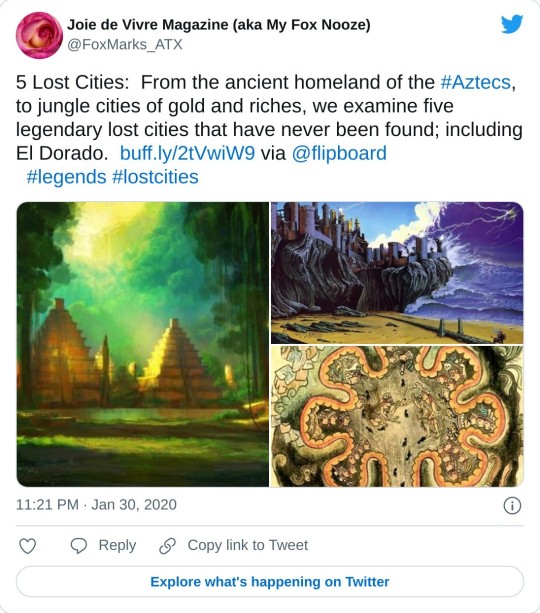
♦♦♦
Archaeologists Claim to have Discovered the Biblical City of Sodom | https://t.co/JmbK4hDElO via @flipboard ~ This claim probably won't be substantiated. Pretty sure the destruction according to the Bible was meant erase all traces. But! ... might find other unexpected treasures.(@cmoneyspinner) January 30, 2020
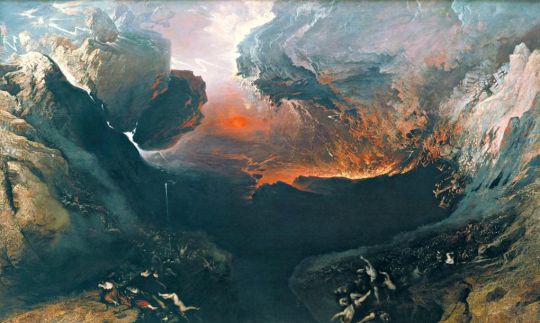
♦♦♦
● Riddle Me This. Why Do Most People Search for #Atlantis and not for Ophir? The land of Ophir mentioned in the Bible has never been found. King Solomon sent ships to this city to bring back algum trees, gold, and precious stones. https://t.co/jAXWfBoMCA #lostcities #ancient pic.twitter.com/s1Ql74Z1bT(@FoxMarks_ATX) January 30, 2020
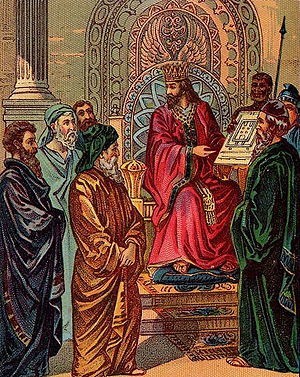
♦♦♦
Using cutting-edge LIDAR technology and AR, @ExplorerAlbert is able to map what Ciudad Perdida looked like during its prime. #LostCities — Nat Geo Channel (@NatGeoChannel) October 29, 2019
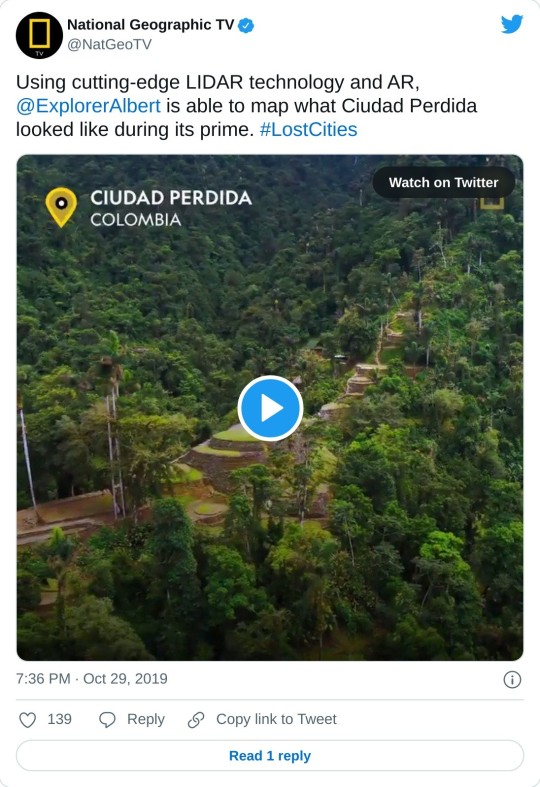
♦♦♦
"#LostCities are funny places; belief in their existence only seems to increase when no one can find them." Another great new @Forbes-#science article by @DSAArchaeology:https://t.co/uQNlHNM2P0— Jens Notroff (@jens2go) May 1, 2019
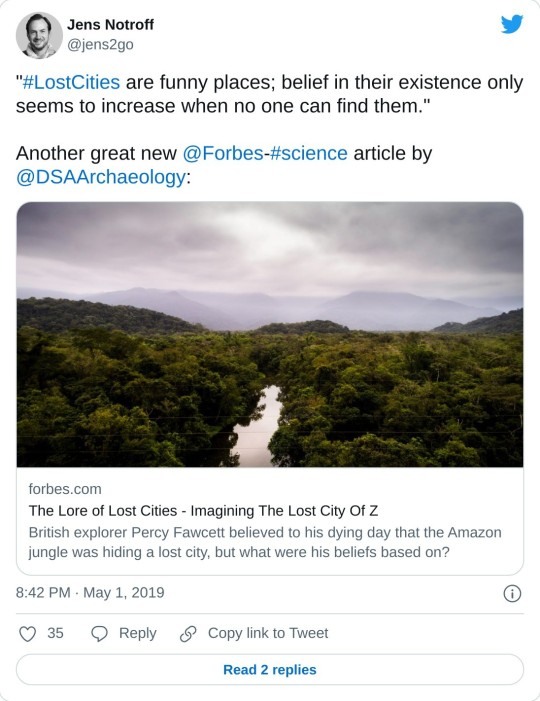
♦♦♦
Death Valley Mysteries The classic book from the 1930s, Death Valley Men, spoke of an underground city below #DeathValley. According to Paiute legend, this city is called Shin-au-av, a name meaning “God’s Land,” or perhaps “Ghost Land.” #LostCities https://t.co/VkDPgHalky— Denver Michaels (@_denvermichaels) January 26, 2020
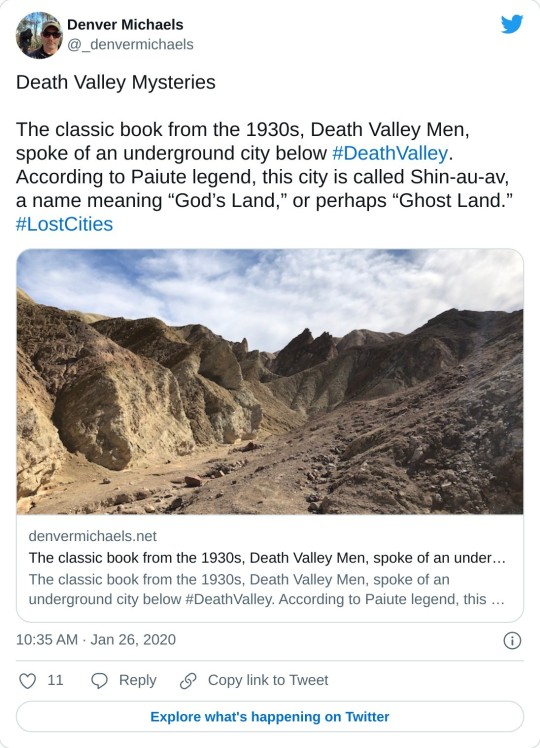
♦♦♦
“#Lostcities are cities that have been built by different #empires during the course of #history and subsequently abandoned and forgotten for long.” Learn about the “10 Most Beautiful Lost Cities” https://t.co/qLn3TO74r2 (@FoxMarks_ATX) January 31, 2020
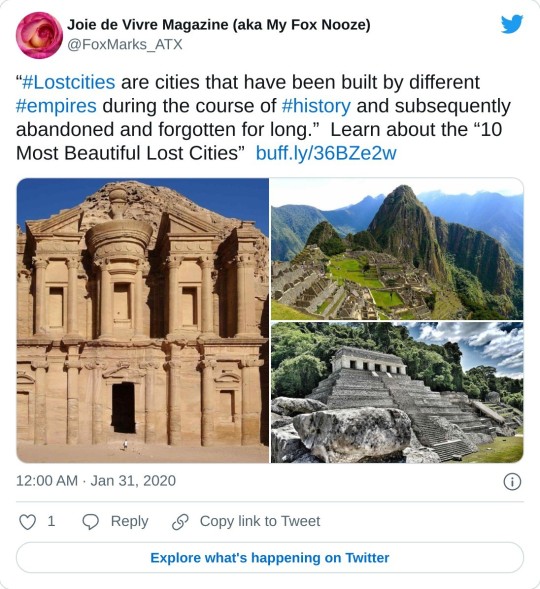
♦♦♦
34 Lost Cities Forgotten by Time (with Photos & Map) - Touropia https://t.co/KcB9b0b0P6 List includes #Carthage, #Troy, #Babylon, ancient cities in #Pakistan, #Thailand, #Zimbabwe, and a preserved Stone Aged village located in Skara Brae. #history #ancientcivilizations (@FoxMarks_ATX) January 31, 2020
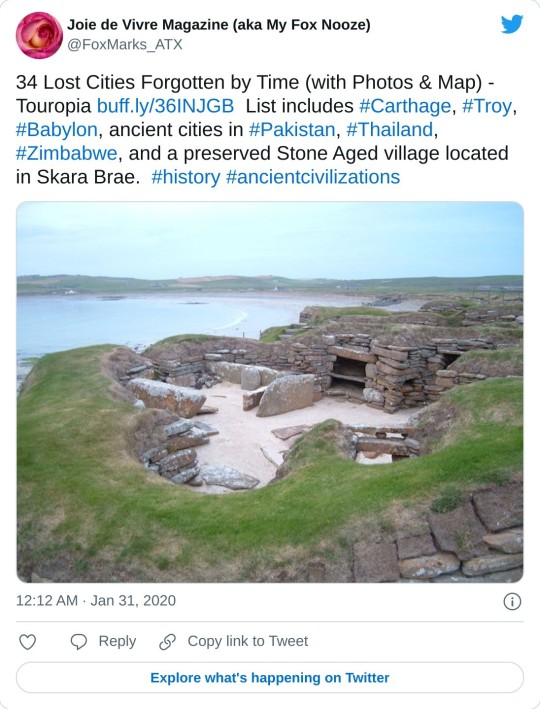
♦♦♦
"6 Lost cities found underwater around the world" ~ https://t.co/4XqbLbmYqV CIties found in #India, #Jamaica, #Greece, #Argentia, #Japan and #China. " ~ Images: China’s Lion City; Port Royal, Jamaica; and Pyramids of Yonaguni Jima - Japan. (@FoxMarks_ATX) January 31, 2020
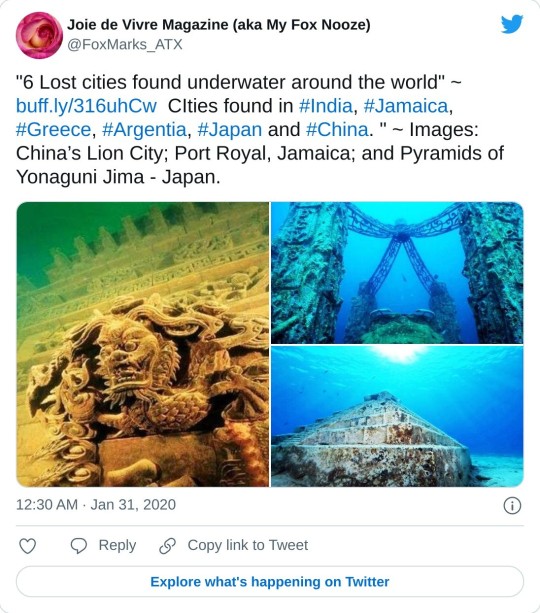
♦♦♦ Do you know any more stories or legends about lost cities?
1 note
·
View note
Text
♛ @fovghtabear

riley liked to think he’d been put on some massive top secret mission, when really, he was the only one who knew about. he found himself in cornwall, in search of the lost city of lyonesse. it is said that it was buried at the bottom of the sea thousands of years ago. he was going to find it, regardless, he would search the entire ocean if he had to. luckily for riley, he was already great at finding things that had been lost for a very long time. he tightened his messenger bag around his shoulder & headed towards the nearest town, where rumours of a lost city were spreading. he found himself chatting away to a man behind a desk in the inn he was residing in for the time being. the man spoke of treasures & monsters that were apparently dragged under the ocean with the city. ❝ —- well, wish me luck, man. the next time i come back here, i’ll have found the city. ❞ he was cocky, but he knew he was that good.
#fovghtabear#i. fovghtabear#{ omg look our muses are bae's in parks. }#{ it's too cute. }#i. adventure found me. { muse: riley }#v. in a world full of heroes. { riley }
5 notes
·
View notes
Text
Factions in the Endless Sea
Factions in the Endless Sea
The problem with the Factions in play in the Endless Sea is that, unlike the Factions in Cambria, they’re much more local.
The rulers of Lyonesse or Iram of the Pillars or Baochuan or Ravenser Odd – whoever they might be – are going to be factions. The various thieves or political advisors or merchants or magicians are also going to be factions. The refugees from the lost city of Ys are probably a…
View On WordPress
#5e#5e D&D#5e dnd#d&d#dnd#endless sea#factions#nautical adventures#roleplay#roleplaying#roleplaying games#rpg
0 notes
Text
Fantasy and Adventure New Release Roundup: 16 December 2017
This week’s roundup of the newest releases in fantasy and adventure features the sole male wizard in his world pressed into an international magical tournament, an American soldier inheriting his family’s Welsh holdings, even more litRPG adventures, and a young Chinese officer facing down a supernatural rebellion.
* * * * *
Exiled: The Odyssey of Nath Dragon (Lost Dragon Chronicles #1) – Craig Halloran
Born into a world of intrigue and mystery… Nath Dragon knows his place in life. Born a man and destined to protect Dragon Home, Nath must carry the burden of his legacy, despite his own desires.
Threatened by a perilous enemy… With cunning dark elves out to destroy Nath, his life takes a turn that threatens to ruin his family. With nobody to trust and nowhere to go, the young warrior sets out to uncover answers that his rivals will kill to protect.
Unleashing the truth changes everything… The closer he gets to the truth, the more dangerous Nath’s quest becomes. Battling ruthless enemies, wizards, dragons, and thieves, Nath uncovers the one thing he thought he always knew: who he really is.
* * * * *
Fight to Live (After the Outbreak #2) – Dave Bowman
Two weeks after the virus outbreak, the trouble is just beginning. Nick, Jessa, and the rest of the group defended their home against a vicious attack. But the worst is yet to come. When Nick is forced to venture into new territory, he discovers just how deadly the world is now. With modern society in ruins, criminal elements are organizing and trying to take control.
Matt Redmond is the only survivor in his town. He needs to get out if he wants to stay alive. A glimmer of hope lies in New Mexico, 800 miles away. It’s a dangerous journey that would test anyone’s bravery. And Matt just turned thirteen.
An alliance brings hope, but not even new friends can help Nick and the others when disaster strikes. With members of the group scattered, can they find their way back to each other? In this dangerous new world, how far will they go for their makeshift family?
* * * * *
Invincible – Kit Sun Cheah
In an Empire beset by internal rebellion and ferocious yaomo, the elite Shenwujun stand ready to defend human civilization. Among the Shenwujun there is none finer than Ensign Zhang Tianyou, who earned the nickname Zhang the Invincible. During a mission to quash a nascent rebellion, a Shenwujun detachment discovers evidence that the Grand Union is supporting the rebels. Zhang is tasked to investigate and destroy this new threat.
But will Zhang the Invincible meet his match at the hands of the rebel called Han the Demon Sword?
“Invincible serves as an excellent and accessible introduction to the genre of xianxia, delivering on the action with generous helpings of the exotic, mortal peril, and moral peril. Zhang is a worthy addition to the pantheon of heroes.”
* * * * *
The Four Nations Tournament (The Aegis of Merlin #6) – James E. Wisher
Four Nations. One Champion.
After a long Autumn, Conryu Koda is ready for a rest.
His hopes are dashed when Chief Kane asks for another favor. Ratings are down for the Four Nations Tournament and having the world’s only male wizard participate is just the thing to give them a boost.
An exhausted Conryu has no interest in playing in an event broadcast world wide. Unfortunately for him, everyone else thinks it’s a great idea. Before he knows it he’s off to London for the games.
But Conryu isn’t the only one visiting the city. The sinister Lady Tiger is in town and she’s got her eye on the other half of the broken elf artifact.
Throw the stunning Heather James, scheming Malice Kincade, and an army of fanatics into the mix and ratings will be the least of Conryu’s worries.
* * * * *
The Jack of Ruin (Unseen Moon #2) – Stephen Merlino
Harric’s immortal enemy, Sir Bannus, lies defeated in the valley, his army buried under tons of mountain rubble—a rock fall that Harric brought down with the magic of the Unseen Moon. For now, the quest to deliver the Queen’s peace treaty to the mysterious Kwendi is safe.
But Sir Bannus rises from defeat with Harric’s name on his lips, vengeance in his fist, and a vow to capture the treaty-bearers and spark war to bring ruin upon the Queen. To Harric, death would be preferable, for if she falls, Sir Bannus or another of the Old Ones will reclaim the throne and cast women and bastards like Harric back into slavery.
Yet Harric’s companions condemn his use of trickery and magic to fight Sir Bannus—tools that saved them once before, and which he believes are as vital as swords for the Queen’s protection.
When treachery, discord, and death doom the quest, Harric must choose between the love and regard of his friends and his self-chosen destiny as Her Majesty’s Unseen protector.
It is a choice that will forever bind him to one…and bring ruin to the other.
* * * * *
Lyonesse Volume 2 – edited by Russel Newquist
Space battles, ghosts of dead politicians, German demon hunters, and interplanetary detectives.
Space warriors battle for a lost cause. Strange things are afoot on the subway. A PR stunt gone wrong brings back the ghost of a dead politician. Children learn to summon demons in school. A major corporation offers hope in the midst of a horrible outbreak… or do they? Interplanetary detectives, alien visitors, and time travel.
Read all these and more in this wondrous second volume, collecting works from the paradigm shifting short fiction service Lyonesse
* * * * *
The Red Plague (Last Warrior of Unigaea #3) – Harmon Cooper
A warrior with nothing left to lose, Oric Rune wants nothing more than to avenge the villagers of Ducat, who were butchered before his very eyes by the Drachma Killers.
But with the people of the Rune Lands encroaching on the southern cities of Unigaea, and something sinister brewing in the sky that could prove fatal to the entire online world, Oric must make the choice between personal vengeance and becoming the hero he is destined to be.
Battered and bruised, but not yet ready to give up on his quest to save Unigaea, Oric and company set off for Tagvornin to address the Red Plague. With a newfound mission, and time running out as the Red Plague continues to spread, the moment for Oric to make his mark on Unigaea is now. But will he be able to? And is it even possible?
* * * * *
Shadow Trapped (Collector Chronicles #3) – D. K. Holmberg
Born of shadow magic. Gifted with the power to control the flame that burns within her. A master strategist. All will be tested by the mysterious Collector.
Carth won the last round, but the game is only beginning.
When the Collector escapes from the prison on Keyall, Carth prepares a daring plan to recapture her, but knows the Collector has already planned for any move she might make.
Discovering what she’s truly after will require an uneasy alliance and leads to a discovery that sends Carth looking into her past to learn how to survive the present.
* * * * *
We, the Two (I, the One #2) – Dominika Lein
In a rush, Hanhoka must reach her long-time colleague before the practice of trading Souls is banned. With her brother, Hinom, at her side, they make their way to the meeting place. Souls are in short supply, things seem desperate, but a rare sighting of the last Soul Hunter offers hope.
Hanhoka schemes and takes advantage of her ability to weave fate —as well as some unlikely connections— to trap the Hunter. Even in these ethereal realms, however, her omniscience is limited and the presence of an ancient, ghastly shadow prevents her plan from being fulfilled without a sorrowful consequence.
“We, the Two” is a short story in an etheric reality where willpower distinguishes the strong from the weak and souls are hunted, captured, even consumed.
* * * * *
Yankee Heir – Patrick A. Nielsen
The year is 1796, and like the fledgling United States Army he serves, Bran Gruffudd is young, reckless, and full of potential; but when victory on the battlefield gives way to tragedy at home, Bran is left with nothing.
Then Bran’s uncle dies, and an unanticipated inheritance and title give the young American the opportunity to begin anew. To secure his ancestral birthright, Bran must first journey across the Atlantic to the Gruffudd family’s four hundred-year-old holdings in southern Wales.
Arriving in Great Britain, Bran’s future is far less bright than he might have hoped. A missing fortune, attempts on his life, unlikely alliances, and a young ward are just some of the surprises that lay ahead. In the end, Bran discovers that true peace will only come through victory, as he once again is forced to take up arms to defend all that he holds dear.
Fantasy and Adventure New Release Roundup: 16 December 2017 published first on http://ift.tt/2zdiasi
0 notes
Photo

SHAPESHIFTER.
Not much is known about the origin of shapeshifters, even to themselves. There are accounts of them through the ages, most widely considered to be true fantasy because shapeshifters rarely reveal themselves. Around the world many of these beings prefer to keep to themselves, but, in recent years, a few have begun to interact more with other supernatural communities.
HISTORY.
Stories of beings who could mimic the shape of any living creature have existed for all time, but history has all but forgotten that such beings really exist. The origins of shapeshifters are unknown even to the wisest among them. However, it is clear to anyone who believes in such things that they have been here for centuries. Some stories hold truth, after all, and within them you can glean the history of a people known to keep to the fringe of society. Through the ages, shapeshifters have acclimated more to living among those not of their kind but it is oft not in their nature to reveal themselves, and they as a species have largely remained silent about their very existence.
IN LYONESSE.
The presence of shapeshifters in Lyonesse is most often traced back to one Henna Sabrah and her family, who approached the Hallowed Council in 1963 to officially announce the presence of her kind in the city. It is unclear whether or not this action was supported by a majority of shapeshifters in the city. In an era where civil rights were being hotly debated, she saw the chance for the betterment of her people by finally moving them out of the shadows so they could mingle with other non-humans. She advocated for explicit rights for her people to be made law in the city, and for a seat on the council to be added so that their voices could be heard among those that govern them.
For a decade, Henna vied for a council position for shapeshifters. Her efforts included rallies, protests, and educational events articulating their needs and wants so as to gain popular support. Her time in the movement was short, but it made its mark and inspired many to take up her cause. In 1974, Henna was assassinated, leaving her family to take up the torch for progression.
To this day, shapeshifters in Lyonesse are still advocating for the recognition of the Hallowed Council, led most solidly by the remaining members of Henna Sabrah’s family.
FACTS.
Can shapeshift into "any creature with a heartbeat."
Average lifespan is ~200 years.
Until 1963 their existence was hotly debated due to their secretive nature
No one except for shapeshifters themselves know what a shapeshifters natural form looks like.
abilities.
Due to their ability to control their bodies, their healing is nearly on par with vampiric regeneration. Cuts will close in minutes, with more severe wounds taking more time. Because of this, one of the only sure-fire ways to kill a shapeshifter is decapitation.
Their agility, dexterity and reflexes vastly surpasses that typical for a human. Often able to pull off acrobatics with great finesse, they move with a preternatural grace.
The ability they’re known for, shapeshifters are able to shift into any living creature - humanoid or animal. They say “anything with a heartbeat” as a way to encompass the vast range of their shapeshifting abilities. Because of this, most people don’t really know for sure what shapeshifters naturally look like.
Because of their ability to control the shape of their bodies, losing a limb isn’t typically a permanent setback for a shapeshifter. After losing an arm, a finger, even an eye a shapeshifter can begin the progress of regrowing the lost appendage. This ability is not instantaneous and is incredibly painful so dismemberment and decapitation are still effective ways of killing a shapeshifter.
Shapeshifters receive emotional impressions of every living creature they encounter. The strength of these impressions is decided by its source, and can range from a light tingle of the senses to an overriding feeling of the emotion itself. For the most part, their empathy begins and ends at simply sensing and feeling what others do, though there are a select few who are able to wield emotional suggestion against those with weaker wills. This ability is innate and shapeshifters have no natural way of switching it off. Those who seek to nullify this ability through magical means may suffer dire consequences to their health and wellbeing.
weaknesses.
Shapeshifters are highly susceptible to the bite and blood of a vampire. They are immune to whatever causes ecstasy from a vampire’s bite and thus feel only pain when bitten. The bite itself tends to get infected and cause trouble for the shapeshifter. Can be deadly, but isn’t always. Their blood, however, is poisonous to them though not always lethal.
Proximity isn’t enough to hurt them, but contact with gold will cause rashes on the skin and weakness in the body. Consumption of gold results in a sickness not unlike food poisoning. While it would take a great deal of gold to kill a shapeshifter, just a little is enough to cause injury.
Shapeshifters are sensitive to the Chaos that all magic stems from. As such, the effects of spells against shapeshifters tend to be amplified. The general rule of thumb for shapeshifters is to avoid magical entanglement where possible.
A blessing and a curse, being burdened with the knowledge and sensation of everyone else’s emotions can be taxing. In states of panic, distress and disaster, shapeshifters can become incapacitated by the surrounding panic. Those who feel their emotions strongly, as well, can leave a shapeshifter feeling weary in their very presence.
ORGANIZATION & SOCIETY.
Shapeshifter culture, such as it is, is largely unconstrained and non-politicized. Solitary shapeshifters are just as common as those who dwell in groups, but all shapeshifters are aware of the secrets of their kind. When they group together, it tends to come more naturally and is a much more casual affair than with other species. A group of shapeshifters is called a family and their inner workings are usually fairly laid back.
families.
Often coming together as a group of friends and then simply growing, shapeshifter families are a grouping of both related and unrelated shapeshifters. They range in size, but average at about ten members though a family could be as small as four or as large as twenty-five. Matriarchal, loosely, in structure, each family has a mother - an elder shapeshifter who offers guidance. As a group, decisions are made by her but her word is not law - families are more loosely organized than that.
mother.
The tentative leaders of each family, the mother is an elder member who guides those within the family. Her job is often as the mothering sort of friend - the one you go to for advice, the one you seek aid from, the one you trust with your worries. First and foremost it is her job to be a confidant for those within the family, and advocate for their betterment. Because of her role, she is afforded the respect and is looked to by those within the family to handle disputes and take up their causes if they have any.
bonding.
The reason a shapeshifter family forms in the first place is to satisfy a need each shapeshifter has: to bond with their fellows. Due to their empathetic natures, shapeshifters can often remain guarded and tense emotionally. The bonding is a simple moment where collective shapeshifters let down their walls and simply feel in unison with those like them.
INTERSPECIES RELATIONS.
In general, shapeshifters are used to remaining partially elusive to those around them by not revealing their supernatural abilities. That said, they are aware of other species and cautious of some. There's a pretty heavy stigma against close relationships with vampires, due in large part to their vulnerability to them. Similarly, their weakness to the Chaos that fuels magic makes them warier of witches than the average person. On the other hand, they tend to feel kinship with werecreatures and other beings that change their shape and it's been known that a shapeshifter may live their lives parading around as one.
MYTHS.
These things do not apply:
"They can only shapeshift into animals." Just as many people believe this lie as know the truth.
They can control peoples emotions. They can't, though select few are able to give others impressions.
FREQUENTLY ASKED QUESTIONS.
Do shapeshifters have superior [strength/speed/senses]?
Short answer: no. Aside from their reflexes and dexterity, none of their senses or facilities are enhanced. At most, they’d be somewhere in the “peak human” levels as far as scale goes.
What is shapeshifting like?
Though painless, the shapeshifter’s body does visibly reshape itself into the shape of whatever they’re turning into. It’s a rather unattractive sight, but one that lasts less than a minute before the shift is complete.
Can they shapeshift into other people?
Yes, they can! Shapeshifters can turn not only into animals and creatures, but other people as well.
Can shapeshifters reproduce?
They can, but only with other shapeshifters if they want shapeshifter offspring. Shapeshifters can only be born of two shapeshifter parents and mating with other species results in either a child the species of the other parent, or some hybrid.
Can shapeshifters be turned into vampires?
Due to their vulnerability to the bite and their blood, the magic that creates vampires just doesn't seem to work on shapeshifters. If they die with vampire blood in their system, they simply die.
Are all shapeshifters in a family?
No, though it is something of a taboo in shapeshifter culture and they miss out on the benefits of the bonding they share with a family.
Can shapeshifters do their empathic bonding with non-shapeshifters?
Yes, though it isn't exactly the same. Bonding is just the letting down of their walls, the sharing in the push and pull of emotions. Anyone emotionally in-tune enough could simulate this experience with a shapeshifter. It's simply stronger between two empathic beings.
0 notes